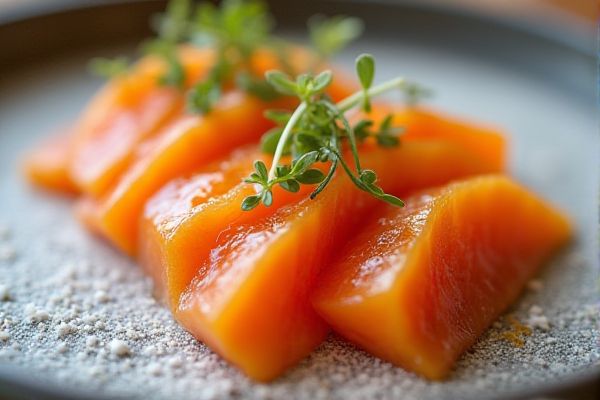
Tasmanian Ocean Trout Sashimi from Nobu features buttery, vibrant orange trout slices adorned with delicate microgreens and a drizzle of tangy yuzu soy sauce, offering a fresh, melt-in-your-mouth experience with a subtle citrus finish.
Equipments
- Sharp sashimi knife
- Cutting board
- Fish tweezers
- Mixing bowl
- Small serving plate
- Squeeze bottle (for sauce)
- Precision tongs (for microgreens)
- Paper towels
- Plastic wrap
Ingredients
- 8 oz (225g) Tasmanian ocean trout (sashimi grade)
- 1 tablespoon yuzu juice
- 2 teaspoons soy sauce
- 1 teaspoon mirin
- Microgreens
- Sea salt
Ensure your Tasmanian ocean trout is sashimi grade to guarantee safety and optimal freshness for raw consumption. Use a sharp sashimi knife to achieve clean, precise slices that enhance the buttery texture and vibrant color. When preparing the yuzu soy sauce, balance the tartness of yuzu juice with soy sauce and mirin to create the classic tangy, citrusy finish. Handle microgreens gently using precision tongs to maintain their delicate appearance and freshness. Your Tasmanian Ocean Trout Sashimi copycat menu will deliver an authentic, melt-in-your-mouth experience reminiscent of Nobu's signature dish.
Instructions
- Chill the sashimi-grade Tasmanian ocean trout in the refrigerator until ready to slice.
- Place the fish on a paper towel-lined cutting board; pat dry with additional paper towels.
- With a sharp sashimi knife, slice the trout against the grain into uniform, thin pieces.
- Remove any stray bones from the slices using fish tweezers.
- Arrange the trout slices, slightly overlapping, on a small serving plate.
- In a mixing bowl, combine yuzu juice, soy sauce, and mirin; mix well.
- Transfer the yuzu soy sauce mixture to a squeeze bottle.
- Drizzle the sauce lightly over the arranged trout slices.
- Sprinkle a touch of sea salt atop the trout.
- Garnish with microgreens using precision tongs for delicate placement.
- Cover loosely with plastic wrap and chill until ready to serve.
Substitution
Tasmanian Ocean Trout Sashimi from Nobu copycat menu highlights the importance of using sashimi-grade Tasmanian ocean trout to ensure safety and premium taste. If you cannot find Tasmanian ocean trout, you can substitute with other fatty fish like sockeye salmon or steelhead trout, which offer similar texture and richness. When slicing the fish, use a very sharp sashimi knife and cut against the grain to achieve delicate, thin slices that enhance the melt-in-your-mouth sensation. In case yuzu juice is unavailable, a mix of fresh lime juice and a splash of orange juice can replicate the tangy citrus flavor in your yuzu soy sauce. Always keep the fish chilled and covered with plastic wrap until serving to maintain freshness and optimal flavor.
Tips
Ensure your sashimi-grade Tasmanian ocean trout is properly chilled and patted dry before slicing to maintain its texture and flavor. Use a sharp sashimi knife to cut thin, even slices against the grain, enhancing tenderness and mouthfeel. Carefully remove any bones with fish tweezers to avoid an unpleasant eating experience. When applying the yuzu soy sauce, control the drizzle with a squeeze bottle to keep the presentation clean, and garnish microgreens gently with precision tongs to preserve their delicate appearance.
Nutritions
Tasmanian Ocean Trout Sashimi provides a rich source of omega-3 fatty acids, which support heart health and brain function. Your serving of 8 oz (225g) offers high-quality protein essential for muscle maintenance and tissue repair. The tangy yuzu soy sauce adds antioxidants and a low-calorie touch, while microgreens provide vitamins A, C, and K for immune support. This dish delivers a nutrient-dense, low-calorie option perfect for maintaining a balanced diet.
Storage
Store your Tasmanian Ocean Trout Sashimi in the coldest part of the refrigerator, ideally at 32degF (0degC), to preserve its freshness and texture. Place the sashimi on a paper towel-lined plate to absorb excess moisture, then cover loosely with plastic wrap to allow some airflow and prevent sogginess. Consume within 24 hours for optimal flavor and safety, as sashimi-grade fish rapidly loses quality after slicing.
Variation or Alternatives
If Tasmanian ocean trout is unavailable, you can substitute with sashimi-grade salmon or Arctic char for a similar buttery texture and vibrant color. Instead of yuzu juice, fresh lime or lemon juice can provide a citrusy brightness to the soy and mirin blend. For a smoky twist, briefly sear the edges of the trout slices before plating, then allow them to cool to retain the delicate, melt-in-your-mouth quality. Your presentation can be enhanced by adding thinly sliced radish or edible flowers alongside microgreens for contrasting colors and textures.
Allergies
Tasmanian Ocean Trout Sashimi contains raw fish, which can trigger allergic reactions in individuals sensitive to seafood or fish proteins. Soy sauce includes soy and wheat, common allergens that may affect those with allergies or gluten intolerance. Your sensitivity to citrus should also be considered due to the presence of yuzu juice in the dish.
Why this recipe?
Tasmanian Ocean Trout Sashimi from Nobu restaurant is prized for its exceptional freshness and rich, buttery texture, enhanced by a delicate balance of flavors from citrus and yuzu kosho seasoning. The menu highlights the premium quality of wild-caught trout from clean Tasmanian waters, known for its vibrant orange flesh and high omega-3 content. You will appreciate how the dish offers a refined taste experience, combining both traditional Japanese techniques and innovative culinary artistry. Trying a copycat version allows you to recreate this gourmet delicacy at home, capturing Nobu's signature umami and vibrant freshness without the restaurant price.
